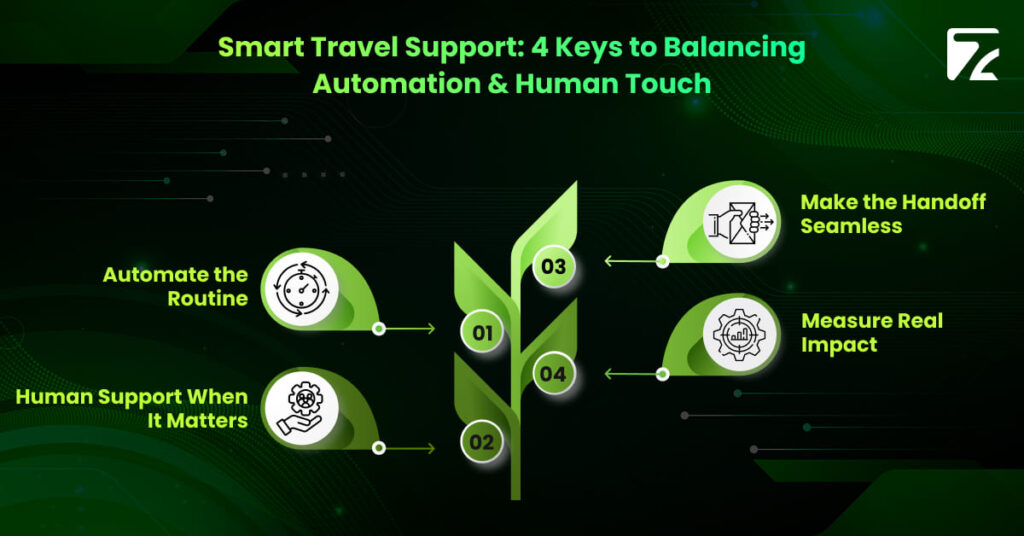You’re running late. Your app updates you on a gate change, reschedules your cab, and emails your boarding pass without you lifting a finger.
That’s when automation works.
Now imagine your flight gets canceled. You open the app for help… and a chatbot keeps asking the same question in a loop.
Frustrating? Absolutely.
That right there is the line every travel company is trying to walk: how do you give travelers fast, automated service without losing the human touch they actually want when things go wrong?
Let’s talk about what to automate, where to pause, and how to strike the balance that keeps people coming back.
Let’s not sugarcoat it travel is chaotic. Thousands of customers. Constant movement. Endless questions.
Automation helps cut through that chaos. It can:
For a business, that’s gold.
No surprise the travel tech market is heading toward $13.4 billion by 2027, with AI and automation fueling the growth.
But here’s where things get tricky: just because a system is fast doesn’t mean it feels good.

Here’s the thing travel is emotional.
Lost luggage. Missed flights. Visa confusion. That stuff triggers stress, and bots aren’t built for empathy (at least not yet).
When someone’s plans fall apart, they don’t want a script they want someone who gets it.
The best customer experience comes from:
People can tell the difference. In fact, a PwC study found that nearly 6 in 10 people think companies have forgotten how to be human. That’s a big miss.
Here’s a simple way to look at it:
| Works Great with Automation | Needs a Real Human |
|---|---|
| Flight updates & notifications | Rebooking after cancellations |
| Hotel check-ins & self-serve kiosks | Handling special requests or VIPs |
| FAQs (baggage, visas, etc.) | Helping during stressful situations |
| Payment & confirmation emails | Planning complex itineraries |
| Loyalty point balances | Personalized upselling based on behavior |
The key isn’t replacing humans it’s knowing where automation fits best.
Some major carriers use bots to send real-time updates and answer routine questions. But when weather disrupts flights, they shift to live agents who can sort things out, rebook trips, or even arrange hotel stays.
They saw a 30% faster resolution rate after making that switch.
Online travel brands often use AI to recommend trips based on browsing history. But if a customer runs into a booking error? Someone calls to follow up. That combo of speed and personal touch keeps conversions high.
Look at every step your customers take from search to post-trip follow-up. Spot the places where speed helps and where human support means more.
Let bots take care of the “where’s my flight?” and “how many bags?” type questions. But always offer a clear path to talk to a human when needed.
When a bot passes someone to an agent, that agent should already know what’s going on. No one wants to repeat themselves.
Automation gets the job done but real connection still comes from people. Invest in soft skills. Teach empathy, cultural awareness, and real problem-solving.
It’s not all about how fast you reply. It’s about how the customer feels after the interaction.
| Metric | Why It Matters |
|---|---|
| CSAT | Did the customer feel satisfied? |
| NPS | Would they recommend you? |
| CES (Effort Score) | Was it easy for them to get help? |
| Bot Resolution Rate | Are bots actually solving problems? |
| Escalation Rate | How often are bots failing and passing it on? |
Here’s what not to do:
Don’t make it impossible to speak to a person. That’s how you lose loyal customers fast.
Automation might reduce the load, but your human agents still shape your brand experience. Train them well.
If people keep complaining about your chatbot? That’s a sign, not a fluke. Don’t ignore it.
AI is getting better every day.
Soon we’ll have bots that recognize frustration in tone.
Voice assistants that offer real options, not just menus.
And personalization that actually feels… personal.
But no matter how good the tech gets; it’s not replacing humans anytime soon.
Especially not when something goes wrong mid-trip.
In travel, people still want people.
This isn’t about choosing between bots or humans. It’s about knowing how to use both together.
Let automation do the heavy lifting.
Let your team step in when emotions, decisions, or nuance are involved.
That’s how you build experiences that run smoothly and feel personal.
Because in the end, great travel isn’t just efficient.
It’s unforgettable.
It handles simple, repetitive tasks fast like flight updates and FAQs freeing up human agents for complex issues.
During stressful moments like cancellations or lost luggage. Bots can’t offer empathy or real problem-solving.
Anything emotional, urgent, or complex like rebooking, VIP handling, or major disruptions.
Let bots handle routine stuff, but always give an easy way to reach a person when needed.
Don’t go full-auto. People still want people especially when things go wrong.

Travel Automation Expert